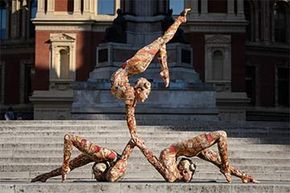If you've had the opportunity to catch a Cirque du Soleil performance, one of the first things you might notice is that this ain't your grandma's tent carnival.
In case the steep price of admission didn't give away that modern circus-type shows have set their sights on grander displays than the circuses of years past, the lush sets, exotic costumes and death-defying contortions and acrobatics should do the trick. There's no bearded lady ready to guess your weight at the MGM Grand, where Cirque's KÀ has been running since 2006. In her place, you'll find performers twirling through the air with little or nothing to hold on to, using cartwheels and handstands to navigate human-sized hamster wheels as they circle the stage. Then they perform a final "battle" scene martial-arts style, while suspended upside down from as far as 90 feet (27 meters) off the ground [sources: Leach, Vegas Chatter].
Advertisement
Yet while the circus arts definitely have evolved from the days when P.T. Barnum and the like crisscrossed the country by wagon and train with a jumbo-sized elephant, modern performances remain largely rooted in some of the skills and techniques developed as far back as ancient Egypt and China and during the Roman Empire. That includes activities like juggling, acrobatics, rope dancing and even the work of clowns [source: PBS].
To this day, body contortionists remain one of the most stunning performers of the circus arts. The ability to twist oneself into a human pretzel and move as if you were made of rubber isn't just a fun cocktail party trick or a good way to make sure that you didn't miss any spots with the suntan lotion. It's a specialty that dates back centuries. Paintings and sculptures from ancient Greece, Rome and Egypt featured depictions of contortionists [source: Simply Circus]. And Mongolia has a rich history in the art, going back to the 17th century. In fact, a Mongolian team has petitioned UNESCO to include contortion on its intangible heritage list [source: Jacob].

